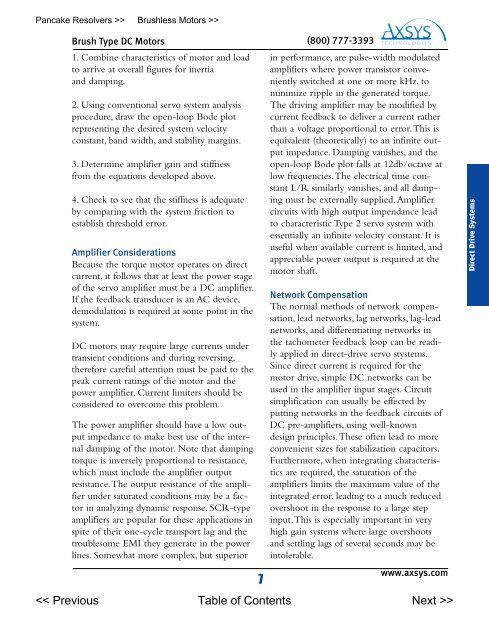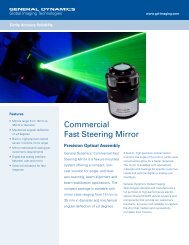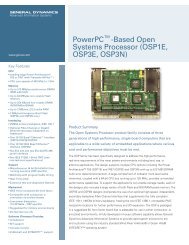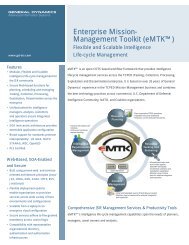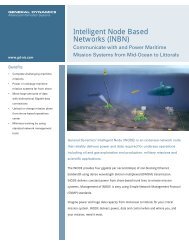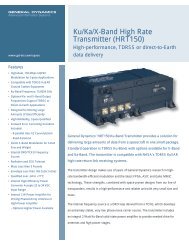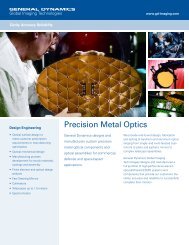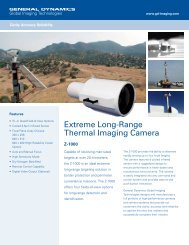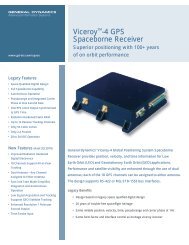Brush Type Manual - General Dynamics Global Imaging Technologies
Brush Type Manual - General Dynamics Global Imaging Technologies
Brush Type Manual - General Dynamics Global Imaging Technologies
You also want an ePaper? Increase the reach of your titles
YUMPU automatically turns print PDFs into web optimized ePapers that Google loves.
Pancake Resolvers >> <strong>Brush</strong>less Motors >><br />
<strong>Brush</strong> <strong>Type</strong> DC Motors<br />
1. Combine characteristics of motor and load<br />
to arrive at overall figures for inertia<br />
and damping.<br />
2. Using conventional servo system analysis<br />
procedure, draw the open-loop Bode plot<br />
representing the desired system velocity<br />
constant, band width, and stability margins.<br />
3. Determine amplifier gain and stiffness<br />
from the equations developed above.<br />
4. Check to see that the stiffness is adequate<br />
by comparing with the system friction to<br />
establish threshold error.<br />
Amplifier Considerations<br />
Because the torque motor operates on direct<br />
current, it follows that at least the power stage<br />
of the servo amplifier must be a DC amplifier.<br />
If the feedback transducer is an AC device,<br />
demodulation is required at some point in the<br />
system.<br />
DC motors may require large currents under<br />
transient conditions and during reversing,<br />
therefore careful attention must be paid to the<br />
peak current ratings of the motor and the<br />
power amplifier. Current limiters should be<br />
considered to overcome this problem.<br />
The power amplifier should have a low output<br />
impedance to make best use of the internal<br />
damping of the motor. Note that damping<br />
torque is inversely proportional to resistance,<br />
which must include the amplifier output<br />
resistance.The output resistance of the amplifier<br />
under saturated conditions may be a factor<br />
in analyzing dynamic response. SCR-type<br />
amplifiers are popular for these applications in<br />
spite of their one-cycle transport lag and the<br />
troublesome EMI they generate in the power<br />
lines. Somewhat more complex, but superior<br />
7<br />
(800) 777-3393<br />
in performance, are pulse-width modulated<br />
amplifiers where power transistor conveniently<br />
switched at one or more kHz, to<br />
minimize ripple in the generated torque.<br />
The driving amplifier may be modified by<br />
current feedback to deliver a current rather<br />
than a voltage proportional to error.This is<br />
equivalent (theoretically) to an infinite output<br />
impedance. Damping vanishes, and the<br />
open-loop Bode plot falls at 12db/octave at<br />
low frequencies.The electrical time constant<br />
L/R similarly vanishes, and all damping<br />
must be externally supplied. Amplifier<br />
circuits with high output impendance lead<br />
to characteristic <strong>Type</strong> 2 servo system with<br />
essentially an infinite velocity constant. It is<br />
useful when available current is limited, and<br />
appreciable power output is required at the<br />
motor shaft.<br />
Network Compensation<br />
The normal methods of network compensation,<br />
lead networks, lag networks, lag-lead<br />
networks, and differentiating networks in<br />
the tachometer feedback loop can be readily<br />
applied in direct-drive servo stystems.<br />
Since direct current is required for the<br />
motor drive, simple DC networks can be<br />
used in the amplifier input stages. Circuit<br />
simplification can usually be effected by<br />
putting networks in the feedback circuits of<br />
DC pre-amplifiers, using well-known<br />
design principles.These often lead to more<br />
convenient sizes for stabilization capacitors.<br />
Furthermore, when integrating characteristics<br />
are required, the saturation of the<br />
amplifiers limits the maximum value of the<br />
integrated error, leading to a much reduced<br />
overshoot in the response to a large step<br />
input.This is especially important in very<br />
high gain systems where large overshoots<br />
and settling lags of several seconds may be<br />
intolerable.<br />
www.axsys.com<br />
><br />
Direct Drive Systems


